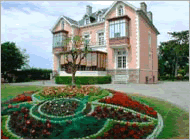Come Back Dior

- SUBSCRIBE
- ALREADY SUBSCRIBED?
BECOME A BONJOUR PARIS MEMBER
Gain full access to our collection of over 5,000 articles and bring the City of Light into your life. Just 60 USD per year.
Find out why you should become a member here.
Sign in
Fill in your credentials below.
 The lavish celebrations and new collection presentations put on July 2 at the Château de Versailles to celebrate the 60th anniversary of the foundation of the haute couture firm of Christian Dior had special meaning for me.
The lavish celebrations and new collection presentations put on July 2 at the Château de Versailles to celebrate the 60th anniversary of the foundation of the haute couture firm of Christian Dior had special meaning for me.
Coming from someone who knows virtually nothing about haute couture , that may seem surprising.
Even worse, although I know virtually nothing now, I knew even less the night of October 23, 1957 when Christian Dior died at his home in Normandy. However, that’s when my link to him began.
I was at that time a budding journalist, quite inexperienced and newly hired by the American News Agency United Press as a desk editor in their Paris bureau.
As the newsroom debutant I had drawn the night shift from midnight to 8: a.m. when usually not much happened and I couldn’t do much damage if I got something wrong.
That night, however, something big happened. News of Dior’s death came clattering over the bureau’s French-language teletypes in the middle of my shift , scarcely a quarter of an hour before all news from Paris that day needed to be sent in a brief electronic burst to the agency’s headquarters in New York.
I thus had to write and send a story about the famous couturier’s passing literally within minutes. This, I learned later, was the man whose dresses were sported by Jackie Kennedy, Eva Peron, Empress Fara Diba of Iran and others. But I didn’t even have time to go to the files and attempt to read the newspaper articles already written about him. In fact, I was so new I didn’t even know where those files were kept.
Luckily I did know—or thought I knew — —one thing. Dior had been responsible for the “New Look” that, in 1947, dropped French women’s skirt levels down below the knees after years of wartime fabric shortages that had kept them much shorter out of sheer necessity.
And so I wrote, breathlessly, something along the lines of “Christian Dior, the man whose words were law on the French couture scene, who could send skirt lengths plunging or upward with a single word, passed away tonight at the age of 52.”
Actually, adding sound effects to the noise of my typewriter (We used typewriters in those days.) it probably was more like:
“Uh, Uh, Christian Dior,…The man who said skirts go up and they went up…Uh, Uh…. or who said skirts went down and they went down…Uh, Uh…died tonight… etc. etc etc. “
Maybe I added a paragraph or two after that but essentially I didn’t know what else to say.
It was scarcely great haute couture coverage but at least I had gotten the news of Dior’s death rapidly to New York. That was a key factor in news agency journalism where success often depended on filing a story minutes ahead of one’s journalistic competitors. The more – qualified New York editors were able quickly to fill in additional data about the man and his career and the agency wound up more or less with a scoop.
After that I always was alert to Dior news not only because he figured in my early journalism career but also because his house on the coast of Normandy in Granville was just minutes away from the summer coastal cottage of my French wife’s family in Carolles where we were married.
That spacious Dior home, Villa des Rhumbs, set amid immense, meticulously tended English-style gardens, and transformed now into a museum, is well worth a visit if you are travelling in Normandy anywhere near the Bay of Mont St. Michel. In the city of Granville just north of the bay, numerous signposts guide visitors toward the museum.
This year’s special exhibition, “Haute en Couleur,” focused on nine different colors that distinguished Dior collections, is open every day from 10: 00 a.m. to 6: 30 p.m until September 23. . Entree fee: 5 Euros. On display are some 80 of Dior’s better-known conceptions from the creation of his haute couture firm to the arrival of its current artistic director, John Galliano, 10 years ago.
In tribute to Dior himself, Galliano’s own 10th anniversary collection this year harked back to the tight-waisted, full-skirted lines that marked Dior’s “New Look” which revolutionized women’s dress styles in 1947 and re-established Paris as the center of the post – World War II fashion world.
As the French guidebooks say: Vaut le détour.
Web site: www.musee-dior-granville.com Telephone: 02 33 61 48 21


